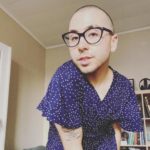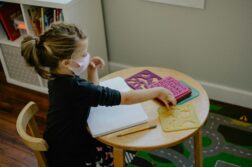
Keith Haring is all over Kutztown. His presence seems only to have increased since he moved away from the sprawling cornfields of our shared hometown in 1976 to live in New York City. It’s his life and story that draw me endlessly back to my hometown and into thoughts about the meaning of queer childhood and young adulthood.
I used to pass his family’s thin brick house on Normal Avenue each day when I’d take a walk after school to clear my head. There’s a Keith Haring statue of a boy and his dog that sits in the town park. My friends would use the statue as a meeting place in the summer when we’d roam the town, bored and trading stories about where we’d like to run away to. At night, we’d scale the statue, perching atop the red metal structure. I remember once climbing up onto the dog’s back after a June storm, slipping, and falling in the grass, laughing, green stains on my jeans.
The archway to the middle school is populated by his stick-body drawings, all moving. When I was younger, I saw them as dancing, but as I get older I begin to consider other motions that the action lines could denote: writhing, shaking, shuttering bodies. An illustration of how a young queer body learns to move.
I imagine Keith gripping the straps of his backpack, stacking books in the high school’s orange metal lockers. What could Kutztown have known of a gay boy in 1974? I wonder if it was the same as it was me—a boy who longed for unreachable words to describe his queerness. I find it comforting to think that Keith and I might have had to bear this same invisibility as young people. I used to think this meant that I didn’t grow up queer, that it was something I only became as I got older. But imagining Keith here too has given me permission to speak the truth, which is that I grew up queer and had no one to share it with.
I knew I liked all genders as early as fifth grade. I imagined myself kissing one of my friends, Katie. She had freckles, blue eyes, and curly brown hair. She did cartwheels whenever there was an open field, and she ate a blueberry muffin in homeroom each day.
I would repeat to myself: “I don’t like girls.” I forced myself to ignore my queerness because I also liked a few boys sometimes, but always the soft boys who, much later, would almost all come out as gay too.
My friend Karl came out to me in seventh grade as gay and a few weeks later I asked him “Is being bisexual a thing? Is that real?” He responded, “I don’t know. I guess so, but I’m not an expert.” That was the closest I came to coming out in Kutztown.
The words queer and trans weren’t in my vocabulary, but I wish they had been. I think they could have given me some way of explaining to myself the huge distance I felt from my body. I remember feeling like I hovered above my young body as she played in leaves and walked along the creek’s winding trails.
I want to know what the word queer felt like in Keith’s mouth, if anyone had hurled it against his body, if he stayed up at night in high school, like me, trying to find language to account for his own skin, language to love with. Who were his crushes, and where did he keep those memories? For me, I have poetry, which is where my young queer desires still live. I write queer and trans love stories not only so young people will see that their love is beautiful and possible, but also to dance with my own ghost—the queer boy I couldn’t yet be in high school.
Grappling with these feelings in college, away from Kutztown, was what made me want to know more about Keith. The more tangible my queerness became, the more desperately I looked for another person that might have known what it was like to grow up a street away from our fields of soybeans, who might have seen the cows lying down in preparation for an afternoon shower.
In all my years in Kutztown School District never once did any teacher tell me that Keith Haring was gay or even an activist. We like to think we’ve come a far way for LGBT rights. Yet in our hometown, Keith’s queerness is hushed, wriggling in the bodies of his figures. Right now, there’s even an anti-critical race theory group in town, trying to keep LGBT books out of school libraries (as well as trying to prevent schools from engaging in vital conversations about race and history).
Keith would have been sixty this year. He passed away from AIDS-related complications in 1990. If I could see him, I would tell him that I look for him everywhere I go. His T-shirts in museum gift shops, his dancing people emulated on the sides of buildings. I would ask him to walk with my up Koffee Lane where the road is gravel and the foxes tear open trash bags for scraps. I would ask him if he ever passed my house on Noble Street.
Before I left Pennsylvania for my New York master’s program, I got Keith’s radiant baby tattooed on my forearm. The baby is a recurring icon of Keith’s and likewise, a repeating image in my life. I remember a print of the radiant baby hung in my pediatrician’s office. I stared up at it playing with wooden puzzles. A version of the baby painted on the middle school walls. Then, a sticker of the baby on a lamppost a block from where I live now in Allentown, Pennsylvania.
The tattoo is over the scars from where I used to self-harm. It reminds me that I have come into being more than once, that ours is a history of scars and radiance, of young queer ghosts we still dance with. I follow mine into poems.
Robin Gow (they/ze/he) was awarded the Jerry Cain and Scott James Creative Writing Fellow and earned their MFA in Creative Writing from Adelphi University where they also taught writing courses as an adjunct professor. Gow runs the trans & queer reading series Gender Reveal Party and co-edits the new magazine The Comments Section.






